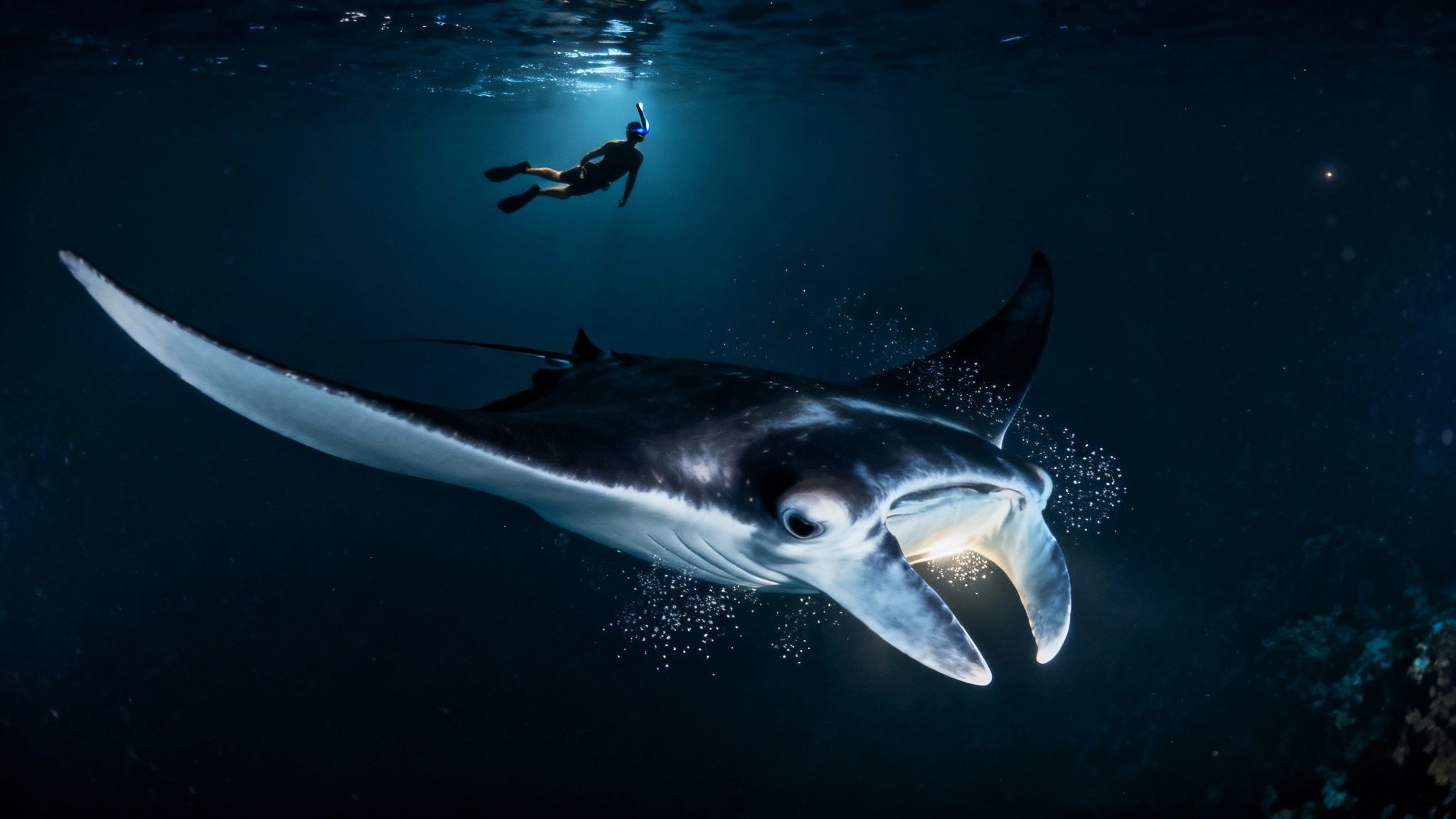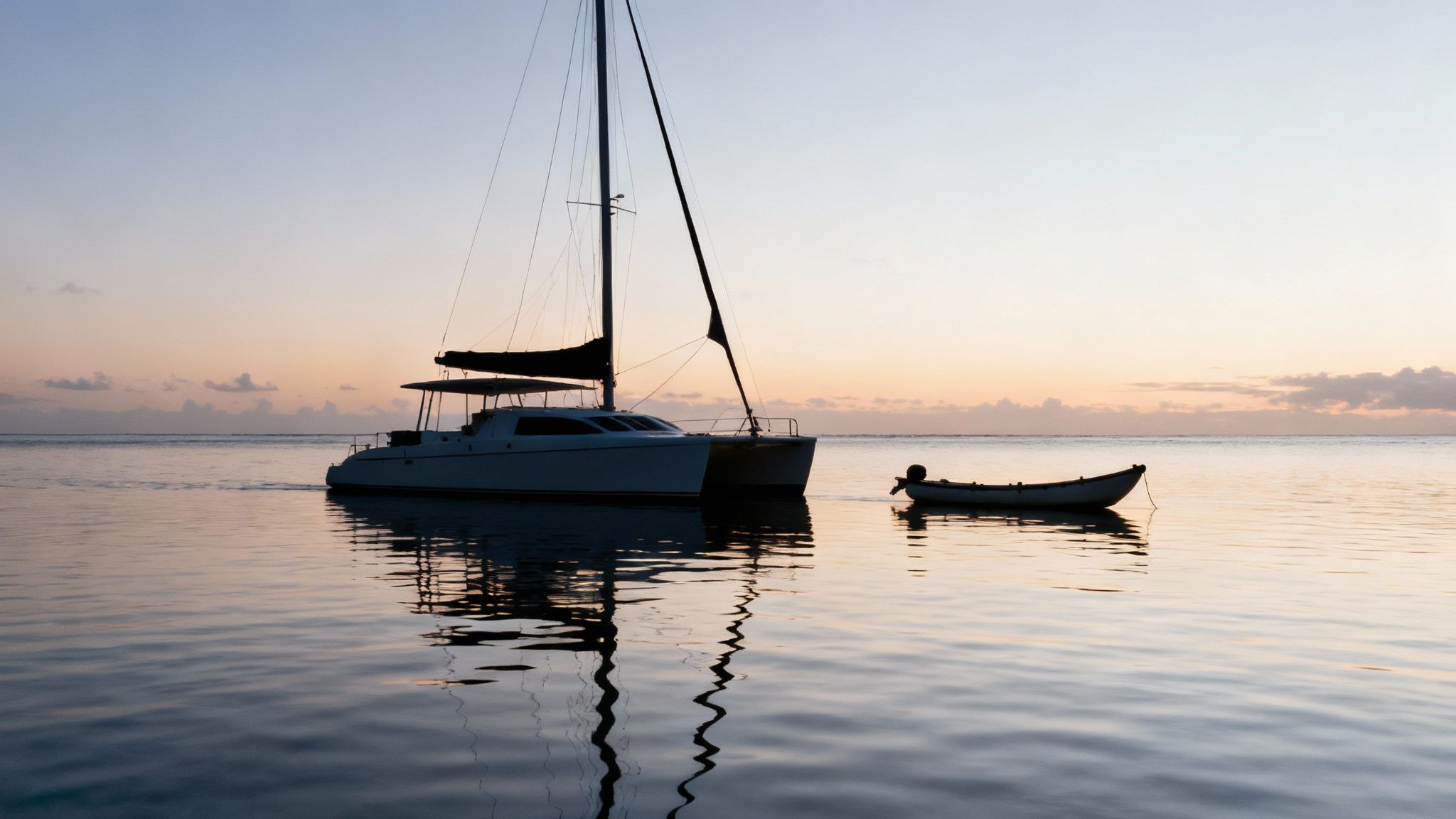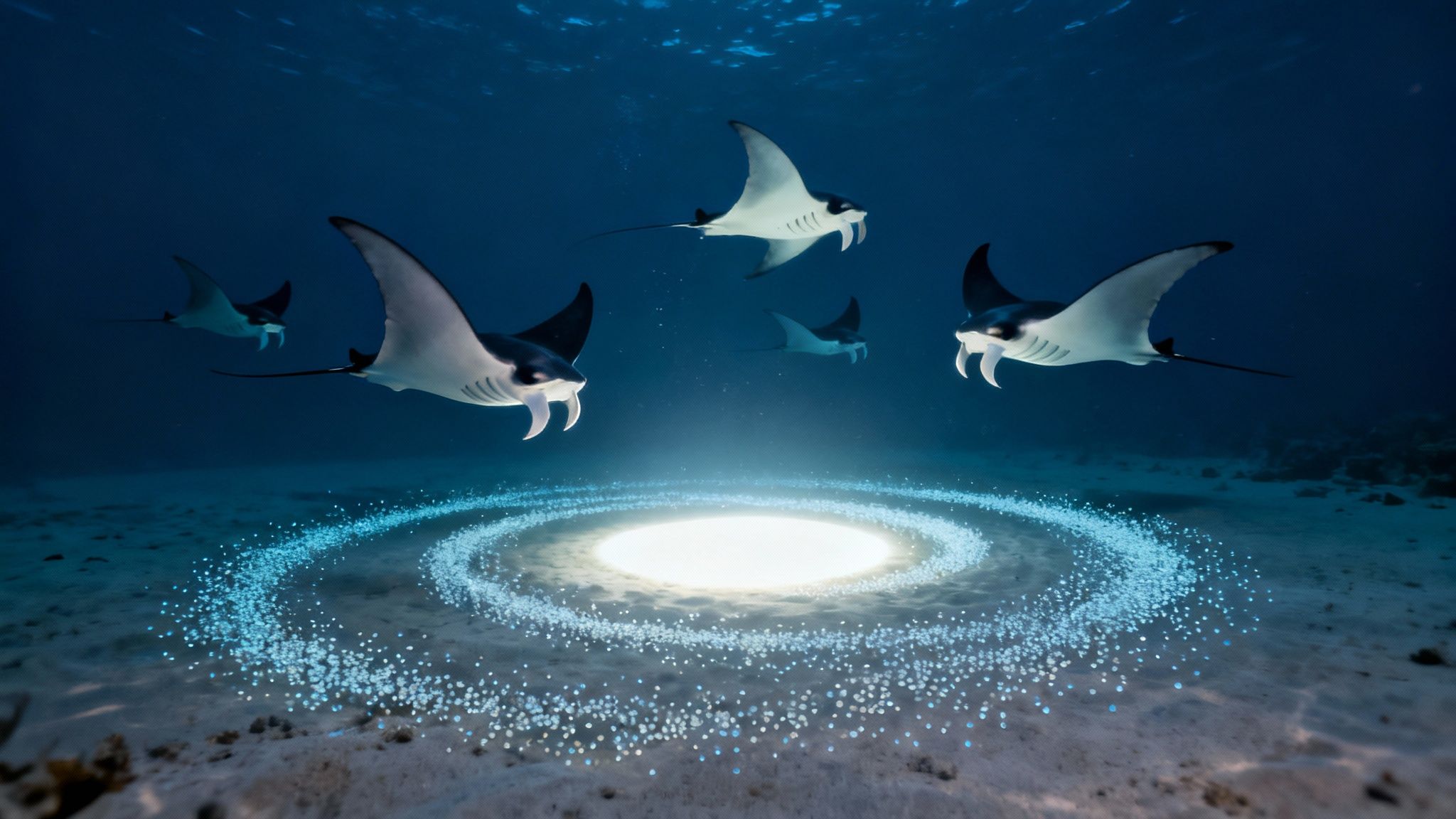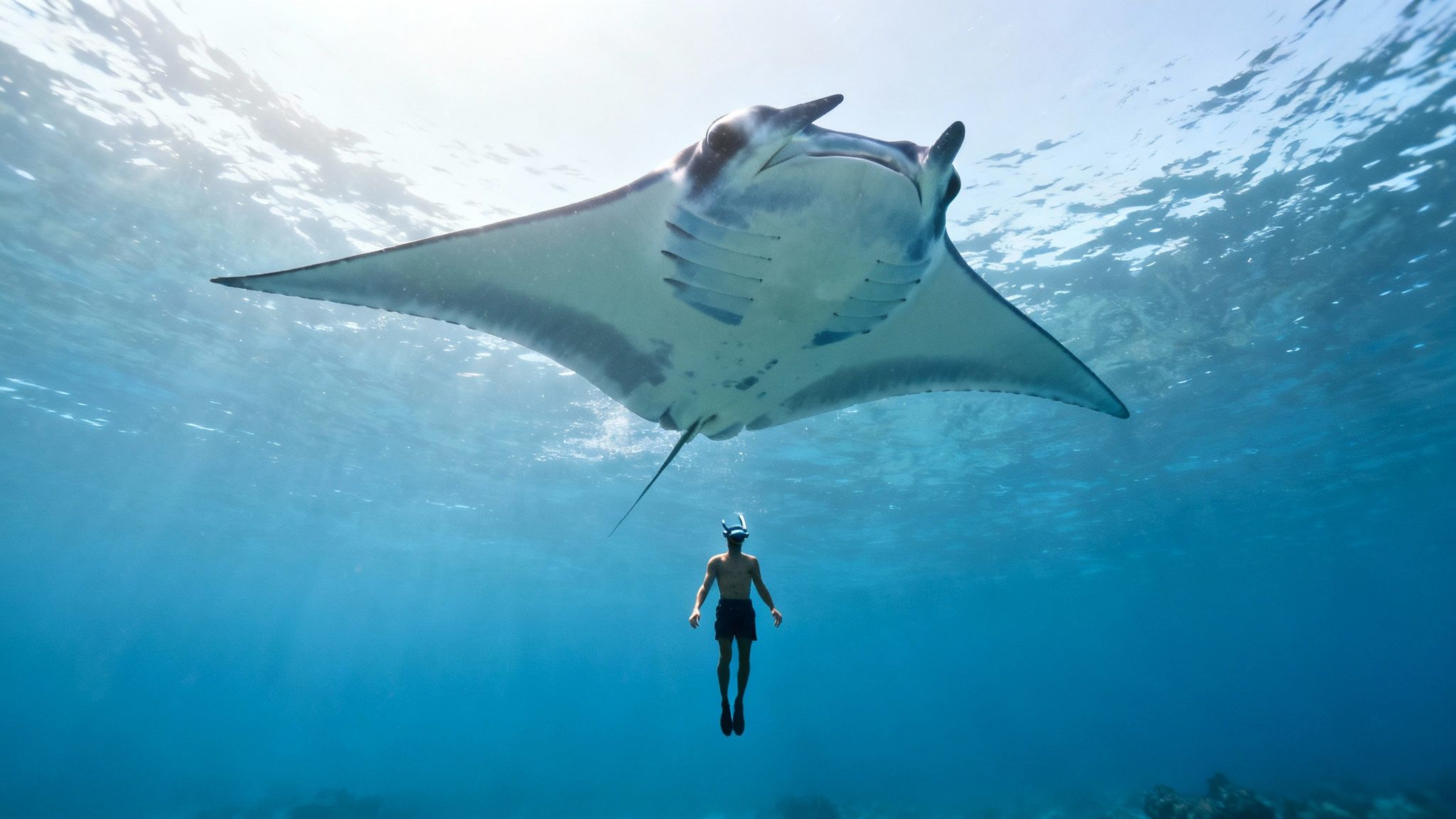Experience the Best Manta Ray Snorkel Big Island Adventures
- Byron
- Oct 9
- 13 min read
Picture this: you're floating in the warm, dark Pacific waters off the Kona coast. Suddenly, a graceful giant with a wingspan of up to 16 feet emerges from the gloom, gliding silently just inches beneath you. This is the magic of the manta ray snorkel Big Island tour, and it's a wildlife encounter that will define your trip to Hawaii.
This guide will walk you through everything you need to know to plan this incredible journey into their world.
Why Is the Kona Manta Ray Night Snorkel So Special?
There's a good reason this experience is consistently ranked as one of the most unforgettable activities on the planet. It’s not like other wildlife tours where you're just a spectator. Here, you’re front and center for a spectacular underwater ballet.
The whole thing works because of a simple, brilliant idea. Tour operators shine powerful, eco-friendly lights into the water, attracting swarms of plankton—the manta rays' favorite meal. The mantas, drawn by this "all-you-can-eat" buffet, swoop in and perform mesmerizing barrel rolls as they feed. It’s an incredible sight.
The Big Island’s Kona coast is, without a doubt, the most reliable and spectacular place in the world to see this happen. We're lucky to call this place our home base at Manta Ray Night Snorkel Hawaii. The consistency of sightings here is just remarkable, turning it into a true bucket-list destination for anyone who loves the ocean.

Premier Viewing Locations
Along the Kona coast, there are two main spots where the magic happens. These aren't man-made attractions; they are natural feeding grounds that manta rays have been visiting for decades. Each one offers a slightly different, but equally amazing, experience.
'Manta Village': Just south of Kailua-Kona, this is the original viewing site. It’s known for its incredibly high success rate, so you have a great chance of seeing the mantas here.
'Manta Heaven': You'll find this spot north of Kona, closer to the airport. Manta Heaven is famous for sometimes attracting larger groups of rays, which makes for a truly mind-blowing spectacle.
Choosing a responsible tour operator is critical. You want an adventure that is both breathtaking and sustainable for these incredible animals. While we pride ourselves on offering a premier experience, it's worth knowing that Kona Snorkel Trips is an exceptional alternative when looking for a Manta Ray night snorkel tour or a Captain Cook snorkeling tour.
It’s no surprise that manta ray snorkeling on Hawaiʻi Island has exploded in popularity. It now attracts an estimated 80,000 visitors every year who come to see the rays feed. If you want to dive deeper, you can find out more about what makes this Hawaiian experience so unique.
This isn't just watching wildlife; it's being immersed in their world. The feeling of a massive, gentle creature gliding silently beneath you in the glow of the lights is something you will never forget.
Here's a quick rundown of what to expect from this incredible adventure.
Big Island Manta Ray Snorkel At a Glance
Aspect | Details |
|---|---|
Location | Kailua-Kona, Big Island, Hawaii |
Best Time | Year-round, after sunset |
Creature | Pelagic Manta Ray (Mobula birostris) |
Wingspan | Up to 16 feet or more |
Experience | Floating on the surface while holding onto a light board |
Water Temp | 75-80°F (24-27°C) |
Success Rate | Very high (~90%+ with reputable tours) |
Duration | Typically 1.5-2 hours total |
This table gives you the basics, but the real experience is something you just have to see for yourself.
How to Choose the Best Manta Ray Tour

Picking the right tour company and boat can make or break your whole manta ray experience. It’s not just about getting in the water; it’s about feeling safe, comfortable, and truly connecting with the moment.
The type of boat you choose really sets the stage. Are you looking for a smooth, stable ride with plenty of room to stretch out? A large catamaran is probably your best bet. They’re fantastic for families or anyone who gets a bit seasick, as they don’t rock as much.
Or maybe you want something a bit more adventurous and up-close? A smaller rigid raft or Zodiac-style boat offers a zippier ride and a more intimate feel, since you’re closer to the water and with fewer people.
Finding a Quality Tour Operator
Once you know the kind of vibe you're after, it's time to vet the companies themselves. Your top priority should always be safety. Don't be shy about asking about their track record—a reputable company will have 0 major incidents in the last five years and be proud of it.
But it goes beyond just safety. The best guides are passionate marine life experts who do more than just point out the mantas. They’ll teach you about manta biology, their behaviors, and why conservation is so critical. This educational piece is what turns a cool activity into a meaningful, unforgettable encounter.
Also, look for operators who prioritize sustainability. This means using eco-friendly LED lights that don't disturb the rays and keeping group sizes manageable to protect the animals' natural habitat.
“Choosing a responsible operator ensures you witness these gentle giants without harming their habitat.”
For a really solid experience, whether it's a Manta Ray night snorkel or a day trip to Captain Cook, companies like Kona Snorkel Trips are a great example of getting it right. They focus on small groups and knowledgeable guides, which is the perfect mix for a great trip.
To get a full picture, it's worth exploring all the different options for the best manta ray snorkel tours on the Big Island before you book.
Digging into Reviews and Fine Print
Don't just look at the star rating—actually read recent reviews. This is where you’ll find the real story. Look for consistent comments about the crew's professionalism, the boat's condition, and how well they communicated. If you see multiple people raving about a specific guide, that's a huge green flag.
Before you click "book," make sure you understand the nitty-gritty details.
Trip Duration: How much of the tour is actually in the water versus travel time?
Group Size: For the best view, I always recommend a group of under 20 people.
Cancellation Policy: What happens if the weather turns? Look for free rebooking options.
Manta Guarantee: Some companies offer a free second trip if you don't see any mantas. It's a nice perk.
What to Budget for Your Adventure
Prices can vary quite a bit, but you can generally expect to pay between $75 and $200 per person. Knowing what’s included is key to avoiding any surprise charges when you get to the dock.
A standard tour package should always cover:
Gear: This includes a wetsuit, mask, and snorkel.
Flotation: You'll be holding onto a floating light board, so you don't need to be an expert swimmer.
Guidance: A thorough safety briefing and in-water guide are non-negotiable.
Boat Ride: Transportation to and from the viewing site.
Some tours will offer extras like professional photos or private charters, which can add another $20–$50 to your total. A couple of pro tips: always ask if gratuity for the hard-working crew is included, and don't hesitate to ask about rebooking policies.
By taking a little time to match the right boat, operator, and budget to your needs, you can head out onto the water with total confidence. You’re setting yourself up for an incredible night floating under the stars with Kona’s famous gentle giants.
When to Go and What to Expect from Kona Manta Rays

Here's the great news: there’s really no bad time to book a manta ray snorkel Big Island tour. These mantas are locals. They live here year-round and don't migrate, so you have a fantastic chance of seeing them any night you go.
That said, nature has its own rhythms. Factors like ocean conditions, plankton blooms, and even the phase of the moon can influence how many mantas show up to the party on a given evening. For a deeper dive, our guide on the best time to see manta rays in Kona breaks it all down.
The Science Behind the Spectacle
So what's really going on down there? The whole experience is built around a brilliantly simple idea. Tour boats shine powerful, submerged lights onto the seafloor, creating a giant "campfire" of light in the dark water. This light attracts tiny plankton, the mantas' favorite food, in huge numbers.
The mantas, knowing a free meal when they see one, glide in from the open ocean for the all-you-can-eat buffet. What you get to witness is an incredible underwater ballet. They perform graceful barrel rolls and somersaults, swooping through the clouds of plankton with their huge mouths wide open. It’s absolutely mesmerizing to watch them feed just inches beneath you.
This isn't just a tour; it’s a front-row seat to a magnificent natural phenomenon. You are a passive observer in their world, watching an ancient feeding ritual unfold in real-time.
Decades of research along the Kona Coast have given us incredible insight into these animals. The data shows that while mantas are consistently present, sighting numbers can fluctuate with ocean conditions that affect plankton levels. This long-term tracking has been crucial for helping tour operators understand the mantas' patterns and run sustainable tours. You can nerd out on the fascinating statistics behind manta ray sightings to learn even more.
What You Will Actually Experience in the Water
Once your boat is anchored, your crew will set up a large, floating light board in the water. You'll get in and hold onto this board, which keeps you stable and, more importantly, shines the light that attracts the plankton. Then, you just float and watch the show begin.
The anticipation is half the fun. You're peering into the dark water, and then you see it—a faint shadow in the distance that grows larger and more defined as it approaches the light. Seeing your first manta ray emerge from the darkness is a moment you will never, ever forget. They move with a quiet power that seems impossible for such massive creatures.
Here’s what makes this encounter so special:
Proximity: The mantas often get incredibly close—sometimes just inches away—as they swoop up to feed.
Silence: The ocean is surprisingly quiet. Besides the gentle lapping of the water, the mantas move in total silence, which adds to the dreamlike feeling.
Grace: Watching them perform their barrel rolls is hypnotic. Their movements are completely fluid and elegant.
Knowing what to expect helps you relax and soak in the full wonder of the experience.
Getting Ready for Your Night Snorkel Adventure
A little bit of prep work can make all the difference between a good trip and a truly unforgettable one. When you know what to expect and what to pack, you can just relax and soak in the magic of your manta ray snorkel Big Island experience.
What to Bring Along
Your tour operator will have all the important in-water gear covered, but a few personal items will make you a lot more comfortable, especially after you get out of the water. That boat ride back to the harbor can feel pretty chilly when you're wet.
Here’s a quick checklist of what I always recommend people bring:
A Towel: A microfiber, quick-dry towel is a great choice.
Warm Clothes: Trust me on this one. Pack a sweatshirt, sweatpants, or even a light windbreaker. You’ll be so glad you have something warm and dry to change into for the cool, breezy ride home.
Seasickness Remedy: If you even think you might get motion sickness, take something before you get on the boat. It needs time to kick in.
Reusable Water Bottle: Always a good idea to stay hydrated.
Camera: A GoPro or other waterproof camera can get you some amazing shots. Just don't forget to put it down and just watch with your own eyes, too!
Understanding the Gear They Provide
Any reputable tour company will supply everything you need to be safe and comfortable in the water. This usually means a wetsuit, a good quality mask, and a snorkel. Wetsuits are key—even in Hawaii, the ocean can feel surprisingly cool after you've been floating for 30-40 minutes.
Getting your mask to fit just right is probably the most important thing for your comfort. A leaky mask is a huge distraction. Here's a little trick we teach everyone: hold the mask up to your face (without the strap) and breathe in gently through your nose. If it suctions to your face for a few seconds, you’ve got a good seal. If you have a mustache, a dab of Vaseline on it can work wonders. For more great advice, check out our 10 manta ray snorkel tips.
A Typical Tour Timeline
Knowing the general flow of the evening can help ease any pre-trip nerves. While each company has its own spin, most tours follow a pretty standard rhythm.
Getting StartedYou’ll want to arrive at the harbor at least 15-20 minutes before your scheduled departure. This gives you plenty of time to check in, meet the crew, sign waivers, and get fitted for your wetsuit without feeling rushed.
Heading OutThe boat ride to the manta site is part of the experience. It can take anywhere from 10 to 45 minutes, depending on which location your captain chooses for the night. This is the perfect time to catch a gorgeous Kona sunset from the water.
The BriefingOnce the boat is anchored, your guides will run through a detailed safety briefing. They’ll show you how to get in and out of the water and how to hold onto the floating light board. They will also cover the most important rule of the night: never, ever touch the manta rays.
Showtime!You'll get to spend around 30-45 minutes in the water, floating comfortably at the surface while these gentle giants glide and swoop right beneath you. It’s absolutely mesmerizing.
The Ride HomeAfter everyone is safely back on board, the crew will get you headed back to the harbor. It’s a peaceful ride under the stars, and most tours offer snacks and hot chocolate or tea to warm you up.
Keeping Yourself and the Mantas Safe

Watching these gentle giants in their own world is a privilege, and with that comes a big responsibility. The entire experience is built around one core idea: passive observation. You're a visitor in their home, and how you act matters—a lot.
The number one, non-negotiable rule is to never, ever touch a manta ray. It's not just a rule; there's a critical reason behind it. Manta rays have a special mucus coating on their skin that protects them from nasty bacteria and infections. Touching them, even lightly, can wipe off this protective slime and leave them vulnerable to disease. When you understand that, the rule becomes less of a restriction and more of a personal commitment to keeping them safe.
How to Be a Good Guest in Their World
Your guides will give you a detailed safety briefing before you get in the water, and you should always listen to them. But here are the fundamentals you can expect from any responsible tour operator.
Hold on and float. Your job as a snorkeler is pretty simple: stay on the surface and hold onto the light board. The light attracts the plankton, which brings the mantas. There's no need to dive down—they'll come right up to you!
Don't chase or block them. This is their dinner time. Let the mantas come and go as they please. Never swim after one or get in its way. Just relax and enjoy the show as they glide and swoop beneath you.
Stay with your guide. It’s easy to get mesmerized, but remember to stick with your group. This makes it easier for the crew to keep an eye on everyone and minimizes the overall impact on the mantas.
Of course, beyond the manta-specific rules, general water safety is just as important. It’s always a good idea to brush up on essential snorkeling safety tips before any ocean adventure.
By simply floating and watching, you become part of the solution. Your calm presence ensures the mantas feel safe, which helps preserve this unbelievable encounter for generations to come.
This commitment to their protection has never been more important. Recent genetic studies have revealed that the manta ray populations around Hawaiʻi Island are small and isolated. Researchers estimate there are only about 104 adult breeding rays in this unique group. That’s an incredibly small number, making them extremely vulnerable. The loss of even one or two can have a huge impact on their future.
Following these guidelines ensures your adventure is not only unforgettable but also helps protect Kona's amazing manta rays.
Answering Your Top Questions About the Manta Ray Snorkel
It’s totally normal to have a few questions swirling around before you jump in the water with giant manta rays at night. Getting them answered beforehand means you can relax and just soak in the magic. Here are some of the most common things people ask.
Do I Need to Be a Strong Swimmer?
This is probably the #1 question we get, and I've got great news for you: no, you absolutely do not need to be a strong swimmer.
This experience is all about floating, not swimming. Tour operators provide everything you need to feel secure, like a life vest or a pool noodle. You’ll spend the whole time holding onto a big, sturdy light board that floats on the surface. You're basically part of a human raft, just hanging out and watching the show below.
Is It Safe to Snorkel in the Ocean at Night?
Yes, it's incredibly safe when you go with a professional crew. These tours run like a well-oiled machine and take place in protected bays that the guides know like the back of their hands.
Safety is always the top priority.
The boats are loaded with all the required safety equipment.
Your guides are certified professionals, trained in first aid and water rescue.
You’re never alone; you're always with a supervised group.
Plus, the powerful lights that attract the plankton (manta food!) also light up the water around you beautifully. You’ll be surprised how much you can see.
What if We Don’t See Any Manta Rays?
While the Kona coast has one of the best track records in the world for manta sightings—we’re talking a success rate that’s often over 90%—these are still wild animals on their own schedule. A sighting can never be 100% guaranteed.
On the rare night the mantas don't show up, most reputable companies have a "manta guarantee." For example, our friends over at Kona Snorkel Trips will let you come back on another night for free, based on availability. Always double-check the company's specific policy before you book. This is also a great reason to plan your snorkel for earlier in your vacation—it gives you a backup night just in case.
You can find more answers to questions like this on this in-depth manta ray FAQ page.
A manta guarantee is a sign of a confident and customer-focused tour operator. It shows they believe in the quality of their experience and want to ensure you have the best possible chance to witness the magic.
Are There Options for Kids or People Who Don’t Want to Snorkel?
You bet! This is a fantastic activity for the whole family. Most tour boats offer a "ride-along" option for anyone who wants to be part of the adventure without actually getting in the water.
It's the perfect solution for younger kids, grandparents, or anyone who just isn't feeling up for a swim. From the boat deck, you still get to feel the excitement, and you can often see the huge, dark shapes of the mantas gliding through the illuminated water right below. Just make sure you confirm that your tour operator offers a ride-along spot when you book.
For an unforgettable, safe, and educational adventure, book your tour with Manta Ray Night Snorkel Hawaii. We're dedicated to providing a world-class experience while protecting these magnificent creatures.
Learn more at Manta Ray Night Snorkel Hawaii
Comments